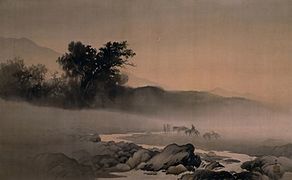|
Kawai Gyokudō
Kawai Gyokudō (川合 玉堂, November 24, 1873 – June 30, 1957) was the pseudonym of a Japanese painter in the nihonga school, active from Meiji through Shōwa period Japan. His real name was Kawai Yoshisaburō.[1] BiographyGyokudō was born in what is now Ichinomiya city, Aichi Prefecture, as the eldest son of a paper, ink and brush merchant. In the spring of 1887, he graduated from Gifu Jinji Kogakko Elementary School, and in September, with a letter of introduction from Aoki Senbashi, entered the school of Mochizuki Gyokusen in Kyoto, where he was given the name "Gyokusyu". He went to Kyoto in 1887 to study under Kōno Bairei of the Maruyama-Shijo school of painting. In 1890, when he exhibited his work at the Industrial Exposition, he changed his name to "Gyokudo" after Gyokusen's name Tama and his grandfather's name Chikudo. In 1896, he moved to Tokyo and he became the student of Hashimoto Gahō, of the Kanō school. He also studied Western-style painting and developed a highly personal style, especially in the field of landscape painting. Gyokudō is noted for his polychrome and occasionally monochrome works depicting the mountains and rivers of Japan in the four seasons, with humans and animals shown as part of the natural landscape. Among his representative works are Futsuka zuki (“The New Moon”), Yuku haru (“The Departing Spring”), Mine-no-yu (“Evening at the Mountain Top”), and Bosetsu (“Snow in the Evening”). In 1898, Gyokudō joined with Okakura Tenshin and Yokoyama Taikan to found the Nihon Bijutsuin (Japan Fine Art Academy). In 1907, Gyokudo was selected as a judge for the first annual Bunten Exhibition. He became a teacher at the Tokyo Bijutsu Gakkō (the forerunner of the Tokyo National University of Fine Arts and Music) in 1919. Received the region of Honor from the French government in 1931 and the Grand Officer Coulonne from the Emperor of Italy in June. In October 1933, he was awarded the First Class Honorary Medal of the Red Cross by the German government. In June 1935, he was appointed a member of the Imperial Academy of Fine Arts. Awarded the Order of the Sacred Treasure, 3rd class, in November 1935. In 1952, Kenso-dong organized a three person exhibition of Gyokudo, Taikan and Ryuko. In 1957, Gyokudo developed heart asthma disease and recuperated, but the disease worsened again in early June and Gyokudo died on the 30th. In 1940, he was awarded the Order of Culture by the Government of Japan. Most of his works are preserved and displayed at the Gyokudo Art Museum, in Ōme, Tokyo. Major works
References
External linksWikimedia Commons has media related to Gyokudō Kawai. |
||||||||||||||||



